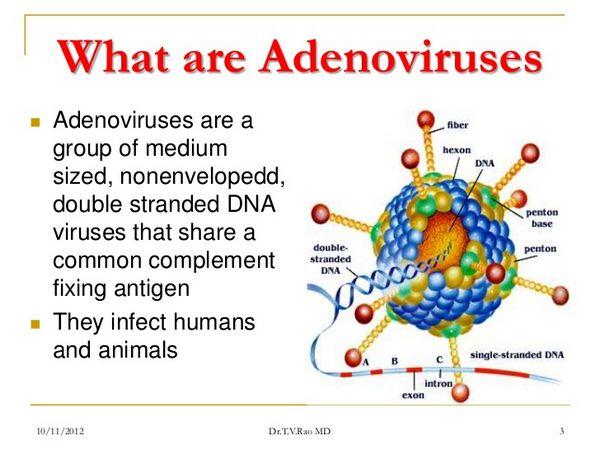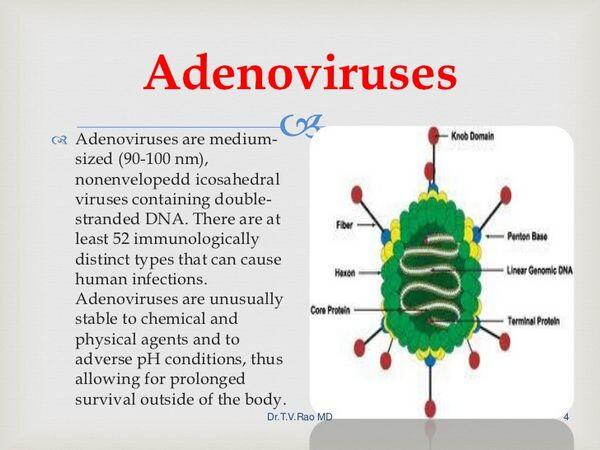Essentials of Diagnosis
- Respiratory symptoms (plus conjunctivitis).
- Disseminated infection in immunocompromised patients.
- Intranuclear inclusions in infected epithelial cells;
- Growth in tissue culture, especially in human embryonic epithelial cells (eg, kidney, lung).
- Antigen detection in clinical samples (eg, respiratory by immunofluorescence).
- Detection of antibody to the adenovirus group antigen by several different assays (eg, complement fixation, hemagglutination inhibition).
General Considerations
Adenoviruses were first isolated in 1953 in human adenoid cell culture. Since then approximately 100 serotypes, at least 47 of which infect humans, have been recognized. All human serotypes are included in a single genus within the family Adenoviridae. Based on homology studies and hemagglutination patterns, each of the 47 serotypes belongs to one of six subgroups. Disorders caused by the adenoviruses include respiratory tract infection, conjunctivitis, hemorrhagic cystitis, and gastroenteritis.

Epidemiology
From 5% to 10% of pediatric respiratory disease can be attributed to adenoviruses. Adenoviruses spread by either respiratory or fecal-oral contact but have been cultured from semen and may also be spread by sexual transmission. Adenoviruses may be shed intermittently from the pharynx and especially in the feces. Most infections are asymptomatic, which greatly facilitates their spread in the community.
Infections with serotypes 1, 2, and 5 are very common in children under 2 years of age and may occur as outbreaks especially in older children. Adenoviruses serotypes 4 and 7 seem especially able to spread and cause outbreaks among military recruits owing to very close, crowded living conditions. Outbreaks of swimming pool conjunctivitis have resulted from inadequate chlorination and the low antibody prevalence to these serotypes in children and young adults.
Microbiology
Adenoviruses are double-stranded DNA viruses with a genome molecular weight of 20 × 106 to 25 × 106 daltons. The core complex within the capsid includes viral DNA and at least two major proteins. In addition there are nine structural proteins.
The virions are nonenveloped icosahedrons with a diameter of 70-90 nm. Projections, or fibers, originate from each of the 12 vertices of the protein capsid. The capsid is composed of 240 capsomeres, which consist of hexons and pentons.
Replication of adenoviruses has been studied extensively in HeLa cell culture. One virus cycle takes ~ 32-36 h and produces 10,000 virions. The replicative cycle is divided into several stages: attachment, penetration, uncoating, and early and late events. Attachment is probably mediated by the viral fiber protein and a receptor on the host cell membrane. There are approximately 100,000 fiber receptors per cell. The virus enters the cell by endocytosis and is uncoated in the cytoplasm, with subsequent replication in the nucleus. This entire process requires 2 h. Early transcriptional events, after shutdown of host cell macromolecular synthesis, lead to gene products involved in viral DNA replication and cell transformation.
Viral DNA replication in the nucleus signals the beginning of the late phase. In addition, late transcripts encode viral structural proteins at a maximum rate 20 h after infection. Virion capsomeres are produced in the cytoplasm and then transported to the nucleus for viral assembly. DNA possibly enters the capsid through an opening at one of the vertices. The mature particle is stable and infectious. Infected host cells release the virus upon degeneration and cell disruption.

Pathogenesis
Adenoviruses infect epithelial cells lining respiratory and enteric organs. After local replication, viremia may occur with spread to visceral organs. This dissemination is more likely to occur in immunocompromised patients. Variations in target cell specificity among adenovirus serotypes result from differences in viral attachment proteins. The virus has a propensity to become latent in lymphoid tissue, such as adenoids, tonsils, or Peyer’s patches, and can be reactivated by immunosuppression.
The histologic hallmark of adenovirus infection is a dense central intranuclear inclusion within an infected epithelial cell. Superficially, this inclusion may resemble those seen in cytomegalovirus infection, but one distinguishing feature is the absence of cellular enlargement (cytomegaly) in adenovirus-infected cells. These inclusions are concentrations of viral DNA and protein. In addition to inclusions, adenovirus infections are characterized by mononuclear cell infiltrates and epithelial cell necrosis. Type-specific neutralizing antibody is associated with protection from reinfection.
Adenoviruses: Clinical Syndromes
Table 1. Clinical syndromes associated with adenoviruses.
Clinical Syndrome
Virus Serotypes
Patient Group
Acute febrile pharyngitis
1, 2, 3, 4, 5, 7a
Young children
Pharyngo conjuntival fever
5a
Older children
Acute respiratory disease including fever, cough pharyngitis, cervical adenitis, and skin rash
2, 3, 4, 5, 7, 8, 11, 14, 21
Military recruits
Conjunctivitis
3, 7, 8, 9, 19
Children and adults
Acute gastroenteritis
40, 41
Infants
Acute hemorrhagic cystitis
11, 21
Young children
Systemic infection in immunocompromised patients
1, 2, 4, 5, 6, 7, 7a, 11, 31, 32, 34, 35
Children and adults
1Highlighted serotypes are especially associated with disease states.
BOX 1. Adenovirus Infection
Children
Adults
More common
- Upper respiratory infection
- Pharyngitis
- Conjunctivitis
- Acute respiratory disease
- Conjunctivitis
Less common
- Hemorrhagic cystitis
- Pneumonia
- Diarrhea
- Pertussislike illness
- Systemic infection in immunocompromised patients
- Pneumonia
BOX 2. Control of Adenovirus Infection
Prophylactic measures
- Vaccine (military recruits)
Isolation precautions
- Respiratory, enteric



